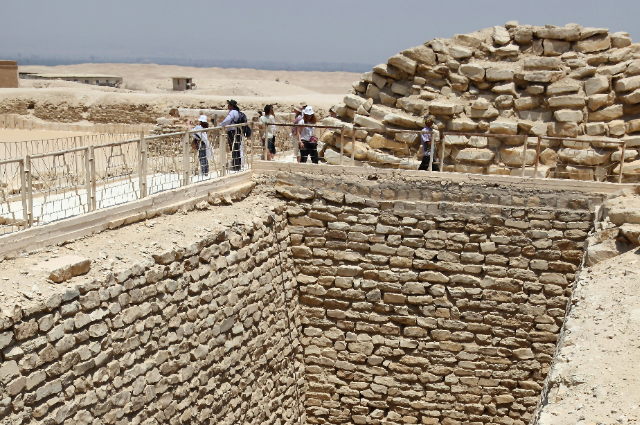
Photo by Nacho Díaz Latorre on Unsplash / Representative Image
In a significant archaeological development, the Archaeological Survey of India (ASI) has unearthed an ancient paleochannel and a remnant of an old river course which was lying buried approximately 23 metres beneath the surface of Bahaj village in the Deeg district of Rajasthan. This finding has generated considerable excitement among historians and archaeologists similar, as many who are now drawing connections between this discovery and the legendary Saraswati river described in the Rig Veda, one of the oldest sacred texts in the world.
Possible Link to the Vedic River Saraswati
The Saraswati river has long been respected in ancient Indian scriptures, particularly the Rig Veda, which portrays it as a mighty and sacred river that nurtured early civilizations. Over time, however, the river is believed to have dried up or changed its course, which is leading to debates and research about its historical existence and trajectory. With the excavation revealing this hidden palaeochannel, experts are speculating whether this could be a physical trace of the river that once held immense religious and cultural significance in Vedic society.
Excavation Timeline and Methodology
The ASI initiated the excavation work in April 2024, and it continued through May 2025. Using advanced geological and archaeological techniques, the team meticulously dug down to depths reaching 23 metres below the village’s present-day surface. What they uncovered was not just an ancient riverbed, but also indications of human habitation and development along its banks.
What makes this find even more extraordinary is the evidence of ancient settlements that thrived in the area between 3500 and 1000 BC. These timeframes coincide with key periods in early Indian prehistory and proto-history, including the late Harappan phase and the early Vedic age. Artefacts, structural remnants, and environmental clues found near the palaeochannel suggest that the region supported a flourishing civilisation, likely sustained by the river’s life-giving waters.
Implications for Indian Historical Studies
This discovery could reshape prevailing narratives about the origins and spread of early civilisations in the Indian subcontinent. If the palaeochannel is indeed a part of the ancient Saraswati river system, it could lend strong support to the theory that a once-mighty river nourished a network of settlements stretching across northwestern India. Moreover, it reinforces the possibility that references in the Rig Veda are not purely mythological but grounded in historical geography.
A Blend of Myth and Science
While the scientific community remains cautious, insisting on further verification through stratigraphic and hydrological studies, the discovery opens the door to a deeper exploration of how myth and history intertwine in the Indian context. The Saraswati has long been a symbol of wisdom and divinity. Now, through the lens of archaeology, it may also become a symbol of rediscovered history.
The unassuming village of Bahaj, located approximately 50 kilometers from Mathura, is rapidly emerging as a site of immense archaeological significance, promising to redefine our understanding of India's early history. Recent excavations have yielded a treasure trove of artifacts and structures, which is prompting the Archaeological Survey of India (ASI) to submit a comprehensive report to the Ministry of Culture for crucial decisions regarding its preservation.
Glimpses into Early Civilizations and Technological Prowess
The ongoing discoveries at Bahaj paint a vivid picture of a long-inhabited settlement with sophisticated advancements. Among the notable findings are remnants of residential structures, characterized by earthen posts and trenches featuring stratified walls, indicating organized habitation patterns. The presence of furnaces alongside a diverse array of iron and copper artifacts strongly suggests that the inhabitants possessed an advanced understanding of metallurgy. As a spokesperson, Gupta, remarked during a recent exhibition of antiquities in Deeg, this discovery alone signifies a remarkable level of technological expertise for the era.
Unravelling Chronological Mysteries: From Pre-Holocene to Ancient Scripts
The antiquity of Bahaj stretches back even further with the unearthing of microlithic tools or small stone implements which indicate the settlement's roots in the pre-Holocene era. This pushes back the timeline of human presence in the region considerably.
Perhaps one of the most groundbreaking discoveries is that of four unbaked sealings, two of which are inscribed with Brahmi letters. These are considered to be the earliest datable evidence of the Brahmi script on the Indian subcontinent, offering invaluable insights into the evolution of writing systems in ancient India.
Spiritual Echoes and Economic Innovations
The excavation has also shed light on the spiritual and economic life of ancient Bahaj. Archaeologists have uncovered 15 yajna kundas (sacrificial pits) and votive tanks dedicated to Shakti worship, along with terracotta images of Shiva and Parvati, dating back to at least 1000 BC. These findings provide crucial insights into the religious practices prevalent during that period. Furthermore, the discovery of yajna kundas from the Mahajanapada period, many of them filled with sandy soil and miniature pots holding uninscribed copper coins has ignited a significant debate among experts. This could potentially challenge existing timelines regarding the origins of Indian coinage, suggesting an earlier emergence of monetary systems than previously understood.
A Hub of Craftsmanship
Beyond metallurgy and religious practices, Bahaj appears to have been a thriving centre for various crafts. The excavation has revealed strong evidence of a rich craft heritage including bone tool industries, the production of semi-precious beads, and shell bangle manufacturing. These discoveries highlight the diverse skills and economic activities of the ancient inhabitants.
As Gupta succinctly put it, "The Bahaj excavation has the potential to rewrite key chapters of India’s early history." The ongoing work at this site is not merely uncovering relics; it is systematically piecing together a more complete and nuanced narrative of India's ancient past, challenging established theories, and offering profound insights into the lives, technologies, and beliefs of its earliest civilizations.
. . .
References:
